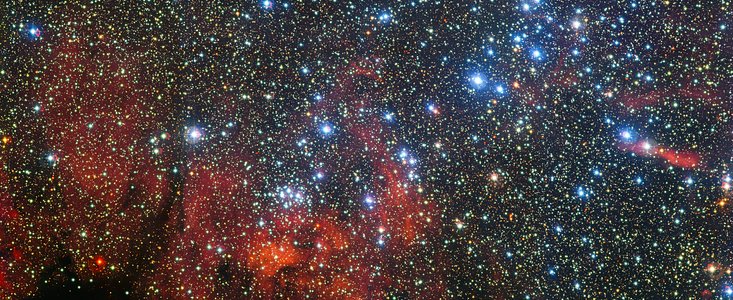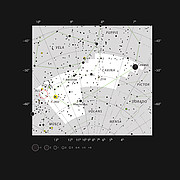Lehdistötiedote
Tähtijoukko Kölin vanavedessä
21. toukokuuta 2014
Tämä värikäs uusi kuva Chilessä sijaitsevalta ESOn La Sillan observatorion MPG/ESO 2.2-metrin teleskoopilta esittää tähtijoukkoa NGC 3590. Nämä tähdet loistavat kirkkaasti tummien tomuläiskien ja hohtavan kaasun runsasväristen pilvien dramaattista taustaa vasten. Tämä pieni tähtien kokoelma tarjoaa tähtitieteilijöille vihjeitä siitä kuinka nämä tähdet muodostuivat ja kehittyivät sekä oman galaksimme spiraalihaarojen rakenteesta.
NGC 3590 on pieni avoin tähtijoukko noin 7500 valovuoden etäisyydellä Maasta Kölin tähdistössä (Carina). Se on noin 35 miljoonaa vuotta vanha kymmenien tähtien kokoelma, jota painovoima pitää löyhästi kasassa.
Tämä tähtijoukko ei ole vain soma. Se on myös hyvin hyödyllinen tähtitieteilijöille. Tutkimalla tätä nimenomaista tähtjoukkoa — sekä muita sen lähistöllä — tähtitieteilijät voivat tutkia oman galaksimme, Linnunradan spiraalikiekon ominaisuuksia. NGC 3590 sijaitsee suurimmassa yksittäisessä osassa spiraalihaaraa, jonka näemme sijaintipaikaltamme galaksissa: Kölin spiraalirakenteessa.
Linnunradalla on useita spiraalihaaroja, galaksin keskustasta ulos kurottavia pitkiä, kaartuneita kaasun ja tähtien virtoja. Nämä spiraalihaarat — kaksi tähtien täyttämää päähaaraa ja kaksi harvempaa, vähäisempää haaraa — on kukin nimetty tähdistöjen mukaan, joissa ne ovat näyttävimmät [1]. Kölin spiraalirakenne näkyy Maapallolta läiskänä runsastähtistä taivasta, Kölin-Jousimiehen vähäisemmässä spiraalihaarassa.
Tämän spiraalihaaran nimi, Köli eli Carina, on varsin asianmukainen. Nämä spiraalihaarat ovat oikeastaan kasaantuneen kaasun ja tähtien aaltoja, jotka kiertävät galaksin kiekossa. Ne laukaisevat säkenöiviä tähtien muodostuksen vyöryjä ja jättävät jälkeensä tähtijoukkoja kuten NGC 3590. Etsimällä ja havaitsemalla tähtijoukossa NGC 3590 sijaitsevien kaltaisia nuoria tähtiä on mahdollista määrittää etäisyys tämän spiraalihaaran eri osiin ja siten saada lisätietoja sen rakenteesta.
Tyypilliset nuoret tähtijoukot voivat käsittää mitä tahansa joistakin kymmenistä muutamaan tuhanteen tähteen ja tarjota tähtitieteilijöille vihjeitä tähtien kehityksestä. Tähtijoukon NGC 3590 kaltaisissa joukoissa sijaitsevat tähdet syntyvät jokseenkin samaan aikaan samasta kaasupilvestä, mikä tekee näistä tähtijoukoista täydellisiä koekenttiä tähtien muodostumisen ja kehittymisen teorioille.
Tämä La Sillan MPG/ESO 2.2-metrin teleskoopin Wide Field Imager (WFI) -havaintolaitteen kuva esittää tähtijoukkoa ja sitä ympäröiviä kaasupilviä, jotka hohtavat oranssin ja punaisen sävyissä seurauksena lähistön kuumista tähdistä tulevasta säteilystä. WFI:n laaja näkökenttä taltioi myös valtaisan määrän taustan tähtiä.
Tämän kuvan koostamiseksi tehtiin lukuisia havaintoja käyttäen eri suotimia, joilla taltioitiin näkymän eri värit. Tämä kuva tehtiin yhdistämällä spektrin näkyvän ja infrapuna-alueen sekä ainoastaan hohtavan vedyn valoa taltioivan erityisen suotimen kuvia.
Lisähuomiot
[1] Näitä neljää haaraa kutsutaan Kölin-Jousimiehen, Kulmaviivoittimen, Kilven-Kentauruksen ja Perseuksen spiraalihaaroiksi.
Lisätietoa
ESO on Euroopan johtava hallitustenvälinen tähtitieteen organisaatio ja maailman tieteellisesti tuotteliain tähtitieteellinen observatorio. ESO:lla on 15 jäsenmaata: Alankomaat, Belgia, Brasilia, Espanja, Iso-Britannia, Italia, Itävalta, Portugali, Ranska, Ruotsi, Saksa, Suomi, Sveitsi, Tanska ja Tšekin tasavalta. ESO toteuttaa kunnianhimoista ohjelmaa, joka keskittyy tehokkaiden maanpäällisten havaintovälineiden suunnitteluun, rakentamiseen ja käyttöön. Välineiden avulla tähtitieteilijät voivat tehdä merkittäviä tieteellisiä löytöjä. ESO:lla on myös johtava asema tähtitieteen tutkimuksen kansainvälisen yhteistyön edistämisessä ja organisoinnissa. ESO:lla on Chilessä kolme ainutlaatuista huippuluokan observatoriota: La Silla, Paranal ja Chajnantor. ESO:lla on Paranalilla Very Large Telescope (VLT), maailman kehittynein näkyvää valoa havainnoiva tähtitieteellinen observatorio, ja kaksi kartoitusteleskooppia. VISTA toimii infrapuna-alueella ja on maailman suurin kartoitusteleskooppi. VLT Survey Telescope on suurin vartavasten taivaan näkyvän valon kartoitukseen suunniteltu teleskooppi. ESO on maailman suurimman tähtitieteellisen projektin, vallankumouksellisen ALMA-teleskoopin eurooppalainen yhteistyökumppani. Parhaillaan ESO suunnittelee 39-metrin kokoista optisen/lähi-infrapuna-alueen European Extremely Large -teleskooppia (E-ELT) josta tulee “maailman suurin tähtitaivasta havainnoiva silmä”.
Linkit
- Valokuvia MPG/ESO 2.2-metrin teleskoopista
- MPG/ESO 2.2-metrin teleskoopilla otettuja kuvia
- Valokuvia La Sillalta
Yhteystiedot
Richard Hook
ESO, Public Information Officer
Garching bei München, Germany
Puh.: +49 89 3200 6655
Matkapuhelin: +49 151 1537 3591
Sähköposti: rhook@eso.org
Pasi Nurmi (Lehdistön yhteyshenkilö Suomi)
ESO Science Outreach Network
ja University of Turku
Turku, Finland
Puh.: +358 29 4504 358
Sähköposti: eson-finland@eso.org
Tiedotteesta
| Tiedote nr.: | eso1416fi |
| Nimi: | NGC 3590 |
| Tyyppi: | Milky Way : Star : Grouping : Cluster : Open |
| Facility: | MPG/ESO 2.2-metre telescope |
| Instruments: | WFI |
Our use of Cookies
We use cookies that are essential for accessing our websites and using our services. We also use cookies to analyse, measure and improve our websites’ performance, to enable content sharing via social media and to display media content hosted on third-party platforms.
ESO Cookies Policy
The European Organisation for Astronomical Research in the Southern Hemisphere (ESO) is the pre-eminent intergovernmental science and technology organisation in astronomy. It carries out an ambitious programme focused on the design, construction and operation of powerful ground-based observing facilities for astronomy.
This Cookies Policy is intended to provide clarity by outlining the cookies used on the ESO public websites, their functions, the options you have for controlling them, and the ways you can contact us for additional details.
What are cookies?
Cookies are small pieces of data stored on your device by websites you visit. They serve various purposes, such as remembering login credentials and preferences and enhance your browsing experience.
Categories of cookies we use
Essential cookies (always active): These cookies are strictly necessary for the proper functioning of our website. Without these cookies, the website cannot operate correctly, and certain services, such as logging in or accessing secure areas, may not be available; because they are essential for the website’s operation, they cannot be disabled.
Functional Cookies: These cookies enhance your browsing experience by enabling additional features and personalization, such as remembering your preferences and settings. While not strictly necessary for the website to function, they improve usability and convenience; these cookies are only placed if you provide your consent.
Analytics cookies: These cookies collect information about how visitors interact with our website, such as which pages are visited most often and how users navigate the site. This data helps us improve website performance, optimize content, and enhance the user experience; these cookies are only placed if you provide your consent. We use the following analytics cookies.
Matomo Cookies:
This website uses Matomo (formerly Piwik), an open source software which enables the statistical analysis of website visits. Matomo uses cookies (text files) which are saved on your computer and which allow us to analyze how you use our website. The website user information generated by the cookies will only be saved on the servers of our IT Department. We use this information to analyze www.eso.org visits and to prepare reports on website activities. These data will not be disclosed to third parties.
On behalf of ESO, Matomo will use this information for the purpose of evaluating your use of the website, compiling reports on website activity and providing other services relating to website activity and internet usage.
Matomo cookies settings:
Additional Third-party cookies on ESO websites: some of our pages display content from external providers, e.g. YouTube.
Such third-party services are outside of ESO control and may, at any time, change their terms of service, use of cookies, etc.
YouTube: Some videos on the ESO website are embedded from ESO’s official YouTube channel. We have enabled YouTube’s privacy-enhanced mode, meaning that no cookies are set unless the user actively clicks on the video to play it. Additionally, in this mode, YouTube does not store any personally identifiable cookie data for embedded video playbacks. For more details, please refer to YouTube’s embedding videos information page.
Cookies can also be classified based on the following elements.
Regarding the domain, there are:
- First-party cookies, set by the website you are currently visiting. They are stored by the same domain that you are browsing and are used to enhance your experience on that site;
- Third-party cookies, set by a domain other than the one you are currently visiting.
As for their duration, cookies can be:
- Browser-session cookies, which are deleted when the user closes the browser;
- Stored cookies, which stay on the user's device for a predetermined period of time.
How to manage cookies
Cookie settings: You can modify your cookie choices for the ESO webpages at any time by clicking on the link Cookie settings at the bottom of any page.
In your browser: If you wish to delete cookies or instruct your browser to delete or block cookies by default, please visit the help pages of your browser:
Please be aware that if you delete or decline cookies, certain functionalities of our website may be not be available and your browsing experience may be affected.
You can set most browsers to prevent any cookies being placed on your device, but you may then have to manually adjust some preferences every time you visit a site/page. And some services and functionalities may not work properly at all (e.g. profile logging-in, shop check out).
Updates to the ESO Cookies Policy
The ESO Cookies Policy may be subject to future updates, which will be made available on this page.
Additional information
For any queries related to cookies, please contact: pdprATesoDOTorg.
As ESO public webpages are managed by our Department of Communication, your questions will be dealt with the support of the said Department.




